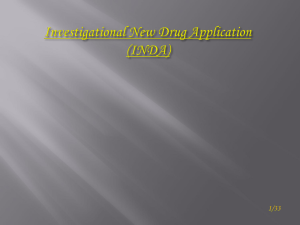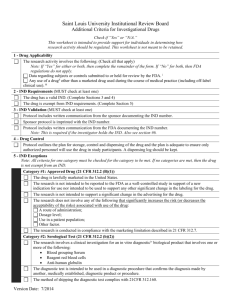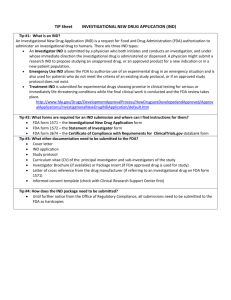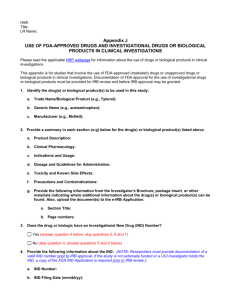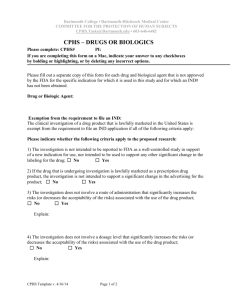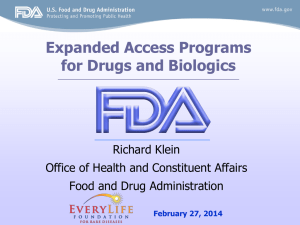Content and Format of an Investigational New Drug (IND
advertisement
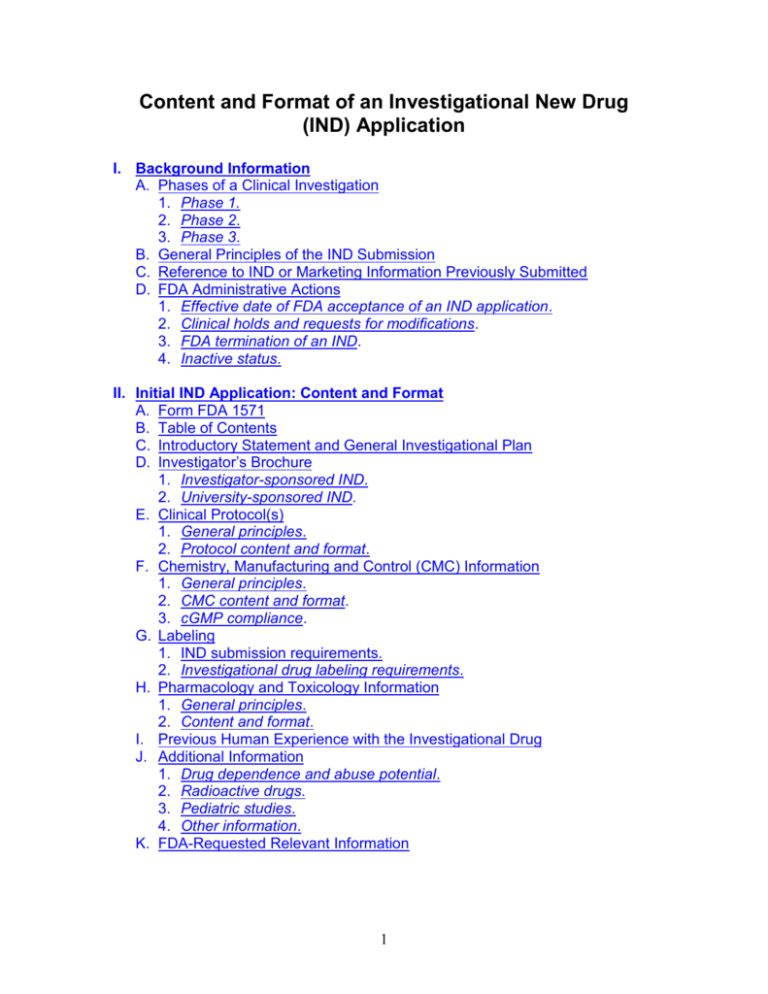
Content and Format of an Investigational New Drug (IND) Application I. Background Information A. Phases of a Clinical Investigation 1. Phase 1. 2. Phase 2. 3. Phase 3. B. General Principles of the IND Submission C. Reference to IND or Marketing Information Previously Submitted D. FDA Administrative Actions 1. Effective date of FDA acceptance of an IND application. 2. Clinical holds and requests for modifications. 3. FDA termination of an IND. 4. Inactive status. II. Initial IND Application: Content and Format A. Form FDA 1571 B. Table of Contents C. Introductory Statement and General Investigational Plan D. Investigator’s Brochure 1. Investigator-sponsored IND. 2. University-sponsored IND. E. Clinical Protocol(s) 1. General principles. 2. Protocol content and format. F. Chemistry, Manufacturing and Control (CMC) Information 1. General principles. 2. CMC content and format. 3. cGMP compliance. G. Labeling 1. IND submission requirements. 2. Investigational drug labeling requirements. H. Pharmacology and Toxicology Information 1. General principles. 2. Content and format. I. Previous Human Experience with the Investigational Drug J. Additional Information 1. Drug dependence and abuse potential. 2. Radioactive drugs. 3. Pediatric studies. 4. Other information. K. FDA-Requested Relevant Information 1 I. Background Information A. Phases of a Clinical Investigation1 An IND application is submitted for a specific drug substance and may incorporate multiple clinical protocols corresponding the various phases of the evaluation of its safety and effectiveness. The clinical investigation of a previously untested drug is typically divided into three phases. Although in general the phases are conducted sequentially, they may overlap. The three phases of a clinical investigation are as follows: 1. Phase 1. Phase 1 includes the initial introduction of the investigational new drug into humans. Phase 1 studies are typically closely monitored and may be conducted in normal volunteer subjects or patients. These studies are designed to determine the metabolism and pharmacologic actions of the drug in humans, the side effects associated with increasing doses, and, if possible, to gain early evidence on effectiveness. During Phase 1, sufficient information about the drug’s pharmacokinetics and pharmacological effects should be obtained to permit the design of well-controlled, scientifically valid, Phase 2 studies. The total number of subjects and patients included in Phase 1 studies varies with the investigational drug, but is generally in the range of 20-80. Phase 1 studies also include studies of structure-activity relationships and mechanism of action in humans, as well as studies in which investigational drugs are used as research tools to explore biological phenomena or disease processes. 2. Phase 2. Phase 2 includes the controlled clinical studies conducted to determine the common short-term side effects and risks associated with the administration of the investigational drug to patients with the disease or condition for which the drug is intended and to evaluate the effectiveness of the investigational drug when administered to such patients. Phase 2 studies are typically well controlled, closely monitored, and conducted in a relatively small number of patients; usually no more than several hundred subjects. 3. Phase 3. Phase 3 studies are expanded controlled and uncontrolled trials. They are performed after preliminary evidence suggesting effectiveness of 1 21 CFR Sec. 312.21 2 the investigational drug has been obtained, and are intended to gather the additional information about effectiveness and safety that is needed to evaluate the overall benefit-to-risk relationship of the drug and to provide an adequate basis for product labeling. Phase 3 studies usually include from several hundred to several thousand subjects. B. General Principles of the IND Submission2 FDA’s primary objectives in reviewing an IND are, in all phases of the clinical investigation, to assure the safety and rights of subjects; and, in Phase 2 and 3 investigations, to help assure that the quality of the respective scientific evaluation is adequate to permit an evaluation of the drug’s effectiveness and safety. Therefore, the FDA’s review of Phase 1 submissions will focus on assessing the safety of the respective investigation(s); whereas the FDA’s review of Phase 2 and 3 submissions will also include an assessment of the scientific quality of the respective investigations and the likelihood that the investigations will yield data capable of meeting statutory standards for granting marketing approval. The amount of information on a particular investigational drug that must be submitted in an IND application to assure the accomplishment of the above objectives depends upon such factors as the novelty of the drug, the extent to which it has been studied previously, the known or suspected risks, and the developmental phase of the drug. The central focus of the initial IND submission should be on the general investigational plan and the protocols for specific human studies. Subsequent amendments to the IND that contain new or revised protocols should build logically on previous submissions/protocols and should be supported by additional information, including the results of animal toxicology studies or other human studies as appropriate. Annual reports to the IND should serve as the focus for reporting the status of the clinical investigations being conducted under the IND and should update the general investigational plan for the coming year. C. Reference to IND or Marketing Information Previously Submitted3 The sponsor of an IND application is not ordinarily required to resubmit information that was previously submitted to the FDA, but may incorporate the information by reference. A reference to information submitted previously must identify the file by name, reference number, volume, and page number where the information can be found. A reference to information submitted to the agency by a person other than the sponsor is 2 3 21 CFR Sec. 312.22 21 CFR Sec. 312.23(b) 3 required to contain a written statement that authorizes the reference and that is signed by the person who submitted the information. D. FDA Administrative Actions4 1. Effective date of FDA acceptance of an IND application. An IND goes into effect (a) thirty (30) days after the FDA receives the IND, unless the FDA notifies the sponsor that the clinical investigations described in the IND are subject to a “clinical hold”; or (b) upon earlier notification by FDA that the clinical investigation described in the IND may begin. FDA will notify the sponsor in writing of the date it receives the IND. An investigator may not administer an investigational drug to human subjects until the IND goes into effect. 2. Clinical holds and requests for modifications.5 A “clinical hold” is an order issued by the FDA to the sponsor to delay a proposed clinical investigation or to suspend an ongoing investigation. The clinical hold order may apply to one or more of the clinical investigations covered under the IND. 4 5 When a proposed study is placed on clinical hold, subjects may not be given the investigational drug. When an ongoing study is placed on clinical hold, no new subjects may be recruited to the study or given the investigational drug; subjects already participating in the study should be taken off the investigational drug unless specifically permitted by the FDA to continue to receive the drug in the interest of the subjects’ safety. Discussion of deficiencies: Whenever the FDA concludes that deficiencies exist in a clinical investigation that may be grounds for the imposition of a clinical hold, the FDA will (unless subjects are exposed to immediate and serious risk) attempt to discuss and satisfactorily resolve the deficiencies with the sponsor before issuing the clinical hold order. FDA’s imposition of a clinical hold: The clinical hold order may be made by telephone or other means of rapid communication or in writing. 21 CFR Part 312, Subpart C 21 CFR Sec. 312.42 4 o The clinical hold order will identify the clinical investigation(s) under the IND to which the hold applies, and will briefly explain the basis for the action. o Within 30 days after imposition of the clinical hold, the director of the FDA’s division with responsibility for review of the IND will provide the sponsor with a written explanation of the basis for the hold. Resumption of studies placed on clinical hold: A study placed on clinical hold by the FDA may not resume until such time that the sponsor has been notified by the FDA that the clinical hold has been lifted. o Resumption of the affected clinical study (studies) will be authorized by the FDA when the sponsor corrects the deficiencies previously cited or otherwise satisfies the FDA that the study (studies) can safely proceed. o If the sponsor of the IND that has been placed on clinical hold requests in writing that the hold be lifted and submits a complete response to the deficiencies identified in the clinical hold order, FDA shall respond in writing to the sponsor within 30 calender days of its receipt of the request and complete response. FDA’s response will either lift or maintain the clinical hold, and will state the reasons for such determination. Notwithstanding the 30 calendar day response time, a sponsor may not proceed with a study on which a clinical hold has been imposed until the sponsor has been notified specifically by the FDA that the hold has been lifted. Conversion of an IND on clinical hold to inactive status: If all clinical studies covered by an IND remain on clinical hold for 1 year or more, the IND may be placed on inactive status by the FDA. 3. FDA termination of an IND.6 FDA may terminate an IND based on deficiencies in the IND or in the conduct of an investigation under the IND. 6 If an IND is terminated by the FDA, the sponsor shall end all clinical studies being conducted under the IND and shall recall or otherwise 21CFR Sec. 312.44 5 provide for the disposition of all unused supplies of the investigational drug. Discussion of deficiencies: Unless the FDA concludes that continuation of clinical studies under the IND presents an immediate and substantial danger to the health of human subjects, a termination order shall be preceded by a proposal to terminate and an opportunity for the sponsor to respond. FDA will, in general, only initiate a termination action after first attempting to resolve the respective issues informally or, when appropriate, through the clinical hold process. FDA’s imposition of a termination order: If the FDA proposes to terminate an IND, it will notify the sponsor in writing and invite correction or explanation within a period of 30 calendar days. o On such notification, the sponsor may provide a written explanation or correction or may request a conference with the FDA to provide the requested explanation or correction. If the sponsor does not respond to such notification within the 30 calendar day period, the IND shall be terminated by the FDA. If the sponsor responds to such notification, but the FDA does not accept the explanation or correction submitted, FDA shall inform the sponsor in writing of the reason for nonacceptance and provide the sponsor with an opportunity for a regulatory hearing before the FDA. The sponsor’s request for a regulatory hearing before the FDA must be made within 10 days of the sponsor’s receipt of the FDA’s notification of non-acceptance; otherwise the IND will be terminated by the FDA. o Immediate termination of an IND: If at any time the FDA concludes that the initiation or continuation of clinical studies under the IND presents an immediate and substantial danger to the health of human subjects, FDA shall immediately, by written notice to the sponsor, terminate the IND. An IND immediately terminated by the FDA due to a dangerous health consideration is subject to reinstatement only by the director of the FDA’s Division with responsibility for review of the IND; i.e., based on additional submissions to the IND that eliminate such danger. 6 If an IND is immediately terminated by the FDA due to a dangerous health consideration, FDA will afford the sponsor an opportunity for a regulatory hearing before the FDA. 4. Inactive status. An IND may be placed on inactive status by either the FDA or the sponsor if (1) no subjects are entered into clinical studies conducted under the IND for a period or 2 years or more; or (2) the IND remains on clinical hold for 1 year or more. o If the FDA acts on its own to place an IND on inactive status, FDA shall first notify the sponsor in writing of this proposed action. Upon receipt of such notification, the sponsor shall have 30 calendar days to respond to the FDA as to why the IND should continue to remain active. If an IND is placed on inactive status, all investigators shall be so notified and all stocks of the investigational drug shall be returned to the sponsor or otherwise disposed of at the request of the sponsor. (See Sponsor Responsibilities) Annual reports: A sponsor is not required to submit annual reports to an IND on inactive status. Resumption of an IND placed on inactive status: A sponsor who intends to resume clinical studies under an IND placed on inactive status shall submit a Protocol Amendment containing the proposed general investigational plan for the coming year and the respective, appropriate clinical protocol(s). o If the Protocol Amendment relies on information previously submitted under the IND, the investigational plan for the coming year shall reference such information. o Additional information supporting the proposed investigational plan shall be submitted in an Informational Amendment. o Clinical studies under an IND on inactive status may only resume (1) 30 days after FDA receives the Protocol Amendment, unless the FDA notifies the sponsor that the clinical studies described in the amendment are subject to a “clinical hold”; or (2) on earlier notification by the FDA that the 7 clinical studies described in the Protocol Amendment may begin. FDA termination of an IND on inactive status: An IND that remains on inactive status for 5 years or more may be terminated by the FDA. III. Initial IND Application: Content and Format The content and format of the IND application set forth below has been adopted from applicable FDA regulations and guidance documents and should be followed by the sponsor in the interest of fostering an efficient FDA review of the submission. It is recognized that certain redundancy exists with regard to this content and format; however such is necessary to permit adequate review of the application by multiple disciplines within the FDA (e.g., pharmacology/toxicology, clinical, chemistry, microbiology). Sponsors are expected to exercise considerable discretion, however, regarding the content of information submitted in each section; depending on the kind of drug being studied and the nature of the available information. The IND content and format requirements set forth below outline the information needed for an sponsor-investigator IND for a new molecular entity. A sponsor-investigator who desires to use, as a research tool, or evaluate an investigational new drug that is already the subject of an industry-sponsored IND or a drug that is currently approved for marketing should follow the same general format, but ordinarily may, if authorized in writing by the drug’s sponsor/manufacturer, refer to the sponsor’s IND or marketing application in providing certain technical information supporting the sponsor’s proposed clinical investigation. A sponsor-investigator who desires to use, as a research tool, or evaluate an investigational drug that is not already the subject of an industry-sponsored IND or currently approved for marketing is ordinarily required to submit all technical information supporting the IND; unless such information may be referenced from the scientific literature. An IND application for initial submission to the FDA shall include, in the following order:7 A. A completed FORM FDA 1571. B. Table of Contents C. Introductory Statement and General Investigational Plan To include: 7 21 CFR Sec. 312.23(a) 8 1. A brief introductory statement giving the name of the drug and all active ingredients; the drug’s pharmacological class; the structural formula of the drug (if known); the formulation of the dosage form(s) to be used; the route of administration; and the broad objectives and planned duration of the proposed clinical investigation(s). 2. A brief summary (if applicable) of previous human experience with the drug, with reference to other IND’s if pertinent, and to investigational or marketing experience in other countries that may be relevant to the safety of the proposed clinical investigations(s). 3. If the drug has been withdrawn from investigation or marketing in any country for any reason related to safety or effectiveness, identification of the respective country (countries) and the reasons for withdrawal. 4. A brief description of the overall plan for investigating the drug product for the following year. The plan should include the following: the rationale for the drug or the research study; the indication(s) to be studied; the general approach to be followed in evaluating the drug; the kinds of clinical trials to be conducted in the first year following the submission (if plans are not developed for the entire year; the sponsor should so indicate); the estimated number of research subjects to be given the drug in those clinical trials; and any risks of particular severity or seriousness anticipated on the basis of the toxicological data in animals or prior studies in humans with the drug or related drugs. D. Investigator’s Brochure An Investigator’s Brochure is not, in general, required for sponsorinvestigator IND applications.8 However, if the University’s IND/IDE Committee has granted approval for the conduct of a multi-center (external site) clinical investigation under a University-based, sponsorinvestigator IND application, an Investigator’s Brochure should be developed for dissemination to each of the involved study sites and should address the following information: 8 21 CFR Sec. 312.55 9 A brief description of the active drug substance and the drug product formulation, including the structural formula of the active drug substance, if known. A summary of the pharmacological and toxicological effects of the drug in animals and, to the extent known, in humans. A summary of the pharmacokinetics and biological distribution of the drug in animals and, if known, in humans. A summary of information relating to the safety and effectiveness of the drug in humans obtained from prior clinical studies. (Reprints of published articles describing such studies may be appended to the Brochure if they are anticipated to be useful.) A description of possible risks and side effects to be anticipated on the basis of prior experience with the drug under investigation or related drugs, and of precautions or special monitoring to be done as part of the investigational use of the drug. E. Clinical Protocol(s) There should be a separate clinical protocol for each planned clinical study of the investigational drug product. (Protocols for clinical studies of the investigational drug product not incorporated into the initial submission of the IND application should be submitted as a Protocol Amendment [see IND Amendments: Requirements and Procedures].) 1. General principles. Phase 1 clinical studies: In general, protocols for Phase 1 studies may be less detailed and more flexible than protocols for Phase 2 and 3 studies. Phase 1 protocols should be directed primarily at providing an outline of the clinical study (e.g., an estimate of the number of patients to be involved; a description of the safety exclusions; and a description of the dosing plan including duration, dose, or method to be used in determining the dose) and should specify in detail only those elements of the study that are critical to safety; such as necessary monitoring of vital signs and blood chemistries. Phase 2 and 3 clinical studies: For Phase 2 and 3 studies, detailed protocols describing all aspects of the study should be submitted. 10 o A protocol for a Phase 2 or 3 clinical study should be designed in such a way that, if the sponsor anticipates that some deviation from the study design may become necessary as the investigation progresses, alternatives or contingencies are built into the protocol at the outset. (E.g., a protocol for a controlled short-term study might include a plan for an early crossover of non-responders to alternative therapy.) 2. Protocol content and format. A protocol is required to contain the following sections; with the specific elements and detail of the protocol sections reflecting the above distinctions depending on the phase of study: A statement of the objectives and purpose of the study. The name and address and a statement of the qualifications (curriculum vitae or other statement of qualifications) of each investigator; the name of each sub-investigator (e.g., health care professional or staff member, research fellow; research coordinator) working under the supervision of the investigator; the name and address of the research facilities to be used; and the name and address of each reviewing institutional review board. The criteria for research subject selection and for exclusion of potential research subjects, and an estimate of the number of research subjects to be studied. A description of the design of the study, including the kind of control group to be used, if any, and a description of the methods to be used to minimize bias on the part of the research subjects, investigators, and data analysts. The method for determining the dose(s) to be administered, the planned maximum dosage, and the duration of individual human subject exposure to the drug. A description of the observations and measurements to be made to fulfill the objectives of the protocol. A description of the clinical procedures, laboratory tests, or other measures to be taken to monitor the effects of the drug in human subjects and to minimize risk. See also Good Clinical Practice (GCP) Guidelines – Clinical Study Protocol and Protocol Amendments 11 F. Chemistry, Manufacturing, and Control (CMC) Information The CMC section of the IND application should include (i.e., as appropriate for the particular clinical study (studies) covered by the IND) information describing the composition, manufacture, and control of the investigational drug substance and the investigational drug product. 1. General principles. Although in each phase of the clinical investigation of an investigational drug sufficient information is required to be submitted to assure the proper identity, quality, purity, and strength of the drug; the amount of information needed to make that assurance will vary with the phase of the investigation, the proposed duration of the investigation, the dosage form, and the amount of information otherwise available. FDA recognizes that modifications to the method of preparation of the investigational drug substance and dosage form (i.e., the investigational drug product) and changes in the dosage form itself are likely to occur as the investigation progresses. Therefore, the emphasis in a Phase 1 submission should generally be placed on the identification and control of the raw materials and the new drug substance. Final specifications for the drug substance and drug product are not expected until the end of the investigational process. Note that the amount of information to be submitted depends also on the scope of the proposed clinical investigation. (E.g., although stability data are required in all phases of the IND to demonstrate that the new drug substance and drug product are within acceptable chemical and physical limits for the planned duration of the proposed clinical study; if very short-term studies are proposed, the supporting stability data can be correspondingly limited.) As drug development proceeds and as the scale or production is changed from the pilot-scale production appropriate for the limited, initial (e.g., Phase 1 and 2) clinical studies to the larger-scale production needed for expanded (i.e., Phase 3) clinical trials, the sponsor should submit Information Amendments (see IND Amendments: Requirements and Procedures) to supplement the initial information submitted on the chemistry, manufacturing, and control processes with information appropriate to the expanded scope of the investigation. 12 2. CMC content and format. Reflecting the distinctions described above, and based on the phase(s) of the clinical study (studies) incorporated in the IND application, the CMC section of the application is required to address the following: Drug substance: A description of the active drug substance, including its physical, chemical, or biological characteristics; the name and address of the manufacturer; the general method of preparation of the drug substance; the acceptable limits and analytical methods used to assure the identity, strength, quality and purity of the drug substance; and information sufficient to support stability of the drug substance during the planned clinical studies. o Note that reference to the current edition of the United States Pharmacopeia-National Formulary (USP-NF), if applicable, may satisfy relevant requirements. Drug product: A list of all components, which may include reasonable alternatives for inactive compounds, used in the manufacture of the investigational drug product, including both those components intended to appear in the drug product and those which may not appear but which are used in the manufacturing process; where applicable, the quantitative composition of investigational drug product, including any reasonable variations that may be expected during the investigational stage; the name and address of the drug product manufacturer; a brief general description of the manufacturing and packaging procedure as appropriate for the drug product; the acceptable limits and analytical methods used to assure the identity, strength, quality, and purity of the drug product; and information sufficient to assure the drug product’s stability during the planned clinical studies. o Note that reference to the current edition of the United States Pharmacopeia-National Formulary (USP-NF) may satisfy relevant requirements. Placebo: A brief general description of the composition, manufacture, and control of any placebo used in the proposed clinical study (studies). 3. cGMP compliance. Note that strict compliance with the FDA’s current Good Manufacturing Practice (cGMP) regulations at 21 CFR Section 211 is not required for 13 investigational drug products being used or evaluated in Phase 1 clinical studies. Rather, for Phase 1 clinical studies, the FDA will hold the sponsor of the IND application accountable for manufacturing and testing the investigational drug in accordance with the respective procedures submitted in the IND application. The manufacture of investigational drug products for use in Phase 2 and 3 clinical studies is, however, subject to full compliance with the FDA’s cGMP regulations at 21 CFR Part 211. A statement addressing whether or not the investigational drug product is being manufactured in compliance with the FDA’s cGMP regulations should be included in the CMC section of the IND application. G. Labeling 1. IND submission requirements. The IND application shall include a copy of all labels that will be assigned to the investigational drug product and, if applicable, all labeling to be provided to each investigator. 2. Investigational drug labeling requirements.9 The immediate package of an investigational new drug intended for human use shall be labeled with the statement “Caution: New Drug – Limited by Federal (or United States) law to investigational use.” The label or labeling of an investigational new drug shall not bear any statement that is false or misleading and shall not represent that the investigational new drug is safe or effective for the purposes for which it is being investigated. H. Pharmacology and Toxicology Information This section of the IND application should include adequate information about non-clinical (i.e., performed in laboratory animals or in vitro) pharmacological and toxicological studies of the investigational drug; on the basis of which the sponsor has concluded that it is reasonably safe to conduct the proposed clinical study (studies) of the investigational drug product. 1. General principles. 9 The kind, duration, and scope of animal and other tests required to adequately support an IND application will vary with the duration 21 CFR Sec. 312.6 14 and nature of the proposed clinical studies(s). (Guidance documents are available from the FDA [see FDA Guidance Documents for Regulated Industry] that describe the ways in which these requirements may be met for various drug products.) o As drug development proceeds, the sponsor is required to submit Informational Amendments (see IND Amendments: Requirements and Procedures), as appropriate, with additional non-clinical information pertinent to the safety of the investigational drug product. 2. Content and format. Qualifications of data reviewer(s): Include the identification and qualifications of the individual(s) who evaluated the results of the animal or in-vitro pharmacology/toxicology studies and concluded that it is reasonably safe to begin the proposed clinical investigation(s) of the investigational drug; and a statement of where the respective records are available for inspection. Pharmacology and drug disposition: Include a section describing the pharmacological effects and mechanism(s) of action of the investigational drug in animals, and information on the absorption, distribution, metabolism, and excretion of the drug, if known. Toxicology: o Provide an integrated summary of the toxicological effects of the investigational drug as observed in the animal studies and in vitro. Depending on the nature of the drug and the phase of the investigation, the summary is to include the results of acute, subacute, and chronic toxicity tests; tests of the drug’s effects on reproduction and the developing fetus; any special toxicity test related to the drug’s particular mode of administration or conditions of use (e.g., inhalation, dermal, or ocular toxicology); and any in vitro studies intended to evaluate drug toxicity. o For each non-clinical toxicology study that is intended primarily to support the safety of the proposed clinical investigation, provide a full tabulation of the respective data suitable for a detailed review. o For each non-clinical laboratory study subject to compliance with the FDA’s Good Laboratory Practice (GLP) regulations (21 15 CFR Part 58)10, provide a statement indicating that the study was conducted in compliance with these regulations. Alternately, specify that the non-clinical study was not conducted in compliance with the FDA’s GLP regulations and describe, in detail, all differences between the practices actually used and those required in the GLP regulations. I. Previous Human Experience with the Investigational Drug Include a summary of previous human experience with the investigational drug, if any, known to the sponsor. This summary is required to include the following information: 1. If the investigational drug has been investigated in humans or marketed previously, either in the United States or other countries, provide detailed information about such experience that is relevant to the safety of the proposed clinical investigation(s) or the investigation’s rationale. If the drug has been the subject of controlled clinical trials, detailed information on such trials that is relevant to an assessment of the drug’s effectiveness for the proposed investigational use(s) should also be provided. Any published material that is relevant to the safety of the proposed clinical investigation or to an assessment of the drug’s effectiveness for its proposed investigational use should be provided in full. Published material that is less directly relevant may be supplied by a bibliography. 2. If the investigational drug product is a combination of drugs previously investigated or marketed, the information required under this section should be provided for each active drug component. However, if any component in such combination is subject to an approved marketing application or is otherwise lawfully marketed in the United States, the sponsor is not required to submit published material concerning that active drug component unless such material relates directly to the proposed investigational use (including publications relevant to component-component interactions). 10 The FDA’s GLP regulations are applicable to non-clinical laboratory studies that support or are intended to support applications for research (e.g., IND applications) or marketing permits for products regulated by the FDA. Non-clinical laboratory studies are defined within these regulations as: “in vivo or in vitro experiments in which test articles are studied prospectively in test systems under laboratory conditions to determine their safety. The term does not include studies utilizing human subjects or clinical studies or field trials in animals. The term does not include basic exploratory studies carried out to determine whether a test article has any potential utility or to determine physical or chemical characteristics of a test article.” 16 3. If the drug has been marketed outside the United States, incorporate a listing of the countries in which the drug has been marketed and, if applicable, identify any of these countries in which the drug has been withdrawn from marketing for reasons potentially related to safety or effectiveness. J. Additional Information For certain IND applications, information related to special topics, as described below, may be required. Such information, if applicable, should be incorporated under this section of the IND. 1. Drug dependence and abuse potential. If the investigational drug is a psychotropic substance or otherwise has abuse potential, describe relevant clinical studies and experience and/or relevant studies in test animals. 2. Radioactive drugs. If the investigational drug is a radioactive drug, provide sufficient data from animal or human studies to allow a reasonable calculation of radiation-absorbed dose estimates to the whole body and critical organs of human subjects. Phase 1 studies of radioactive drugs must include a clinical investigation directed at obtaining sufficient human data for direct human radiation dosimetry calculations. 3. Pediatric studies. Incorporate, if applicable, plans for assessing pediatric safety and effectiveness of the investigational drug. 4. Other information. Include, if applicable, a brief statement addressing any other information that would assist an evaluation of the proposed clinical investigations of the investigational drug with respect to their safety, or their design and respective potential as controlled clinical trials to support marketing of the drug. K. FDA-Requested Relevant Information If requested by the FDA (e.g., FDA comments associated with a Pre-IND meeting/assessment), include any other relevant information needed for review of the IND application. 17

